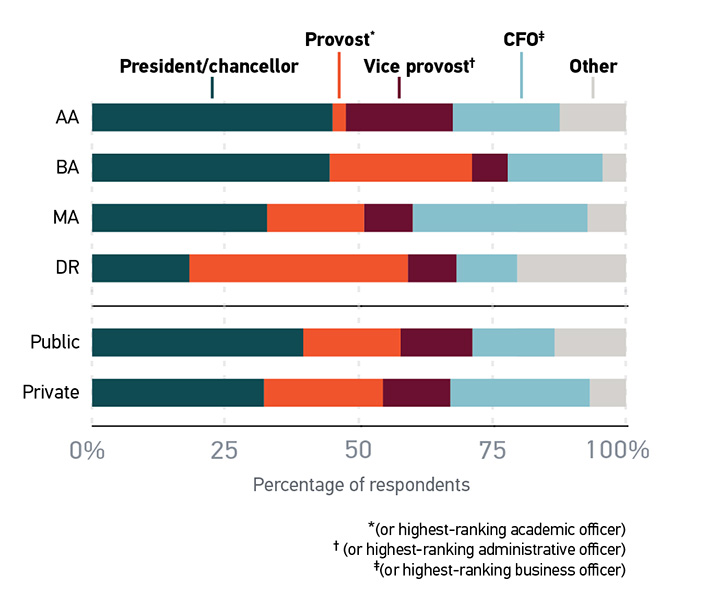Find out who reports to whom among higher education IT leaders.

The EDUCAUSE Center for Analysis and Research wrapped up its IT Workforce in Higher Education, 2016 series of research reports last fall. This series includes IT leadership reports on the chief information officer (CIO), the chief information security officer (CISO), the enterprise architect (EA), and the chief data officer (CDO). These studies identified the characteristics and functions of these IT leadership positions — the background and training these individuals possess, the personal and professional characteristics that contribute to their success, and their scope of work and responsibilities. This post expands on some of the data presented in these reports.
The surveys of IT leaders asked respondents to identify the position to which they report. Most of the positions on these lists were shared across all of the four leadership positions, with a few differences reflecting the typical "location" of each position in the organizational hierarchy. There is, after all, a finite number of positions in the C-suite and other leadership roles in any organization.
One of the most notable findings from across the four reports was the diversity in reporting relationships. CIOs have an extremely broad scope of responsibility, and so one might expect that the three other positions report to the CIO, but this is not uniformly the case. CISOs overwhelmingly (83%) report to the CIO, while less than half of EAs and CDOs do (42% and 41%, respectively). For the remainder, small percentages of EAs, CDOs, and CISOs report to many other positions, both those hierarchically on a level with the CIO (e.g., the chief financial officer) and those hierarchically above the CIO (e.g., the provost).
CIOs, for their part, also have a wide range of reporting relationships. About a third report to the president or chancellor (34%), while about a fifth each report to the provost, the CFO, and the vice president or vice chancellor (20%, 19%, and 17%, respectively).
Making these reporting relationships even more complex is that a small percentage of all four positions report jointly to two different positions: Approximately 2% of CIOs report jointly to the provost and the CFO, while another roughly 2% of CIOs report jointly to the president and some other position (1.3% CFO, 0.4% provost). Approximately 3% of CDOs report jointly to the provost and the CFO.
And as if these reporting relationships weren't complex enough, several respondents in all four positions wrote that they additionally have dotted-line reporting relationships to various positions in the C-suite and above.
Figure 1 shows a simplified view of reporting relationships in higher education IT. As mentioned above, the lists of reporting positions were mostly identical for the four IT leadership positions surveyed.

Figure 1 shows who reports to whom, overall, across all respondents in all types of institutions. There was, however, some variation in reporting relationships by type of institution. Figure 2 presents some of these differences for CIOs. There was some variation in reporting relationships by type of institution for EAs, CDOs, and CISOs, as well. However, the EA and CDO studies had low response rates, and stratifying the responses by institution type made it impossible to determine if those variations are statistically significant. Also, recall that CISOs overwhelmingly report to the CIO; that percentage of respondents so dwarfs all other reporting relationships that again, stratifying the remaining responses by institution type made it impossible to determine if variations are statistically significant. Therefore only data for CIOs are reported here.

The most striking variation in CIOs' reporting relationships is in reporting to the provost versus the president or chancellor. A far greater percentage of CIOs at doctoral institutions report to the provost (41%) than at any other type of institution; a far greater percentage of CIOs at bachelor's and associate's institutions report to the president or chancellor (44% and 45%, respectively). At master's institutions, CIOs are evenly split between reporting to the president/chancellor and the CFO (both 33%). These findings seem to indicate that at doctoral institutions, the CIO role is tightly integrated into the academic mission of the institution, while at master's, bachelor's, and associate's institutions, the role is more closely aligned with the operational and business side of the institution.
Jeffrey Pomerantz is Associate Professor of Practice and the Coordinator of Online Programs in the School of Library and Information Science at Simmons College.
© 2018 Jeffrey Pomerantz. The text of this work is licensed under a Creative Commons BY-NC-SA 4.0 International License.
